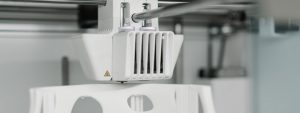Recognizing High-Performance Materials
It is well-known that Boeing, the aerospace manufacturer giant, has been aggressively using additive manufacturing in their craft designs and processes. Recently, the company has qualified 3D printer OEM Stratasys’ Antero 800NA thermoplastic filament for their flight parts. Hence, the filament can now be used to manufacture end use components aboard its planes.
What is the Antero 800NA filament?
The Antero 800NA is a high-performance PEKK-based polymer. It is designed specifically for Stratasys’s industrial-grade FDM 3D printers (ex. F900 and the Fortus 450mc). The combined excellent mechanical and low outgassing properties of PEKK with the design freedom of FDM 3D printing is a beneficial proposition.
A high-performance polymer is also called high-temperature plastic or high-performance thermoplastic. They are different from other types of plastic. They are distinguished by their temperature stability and their mechanical properties. They are often chosen for applications requiring good chemical resistance, performance at high temperatures, low coefficient of friction and high strength. They are used in many demanding applications across different industries such as oil and gas, nuclear, chemical, and aerospace. High-performance plastics include: PTFE, PCTFE, PEKK, PEEK, PFA, FEP, ETFE, ECTFE, PPS, and PES.
The Antero 800NA has a tensile strength of 93MPa and an elongation at break of 6%. The high strength, heat and chemical resistance, toughness, and wear resistance of the filament make it an excellent alternative to metals such as aluminum for aerospace applications.
Stratasys says that Boeing has recognized the beneficial use of the Antero polymer to meet applications that couldn’t have been 3D printed before. Additive manufacturing is ideal for simplifying aerospace supply chains both in original equipment and the maintenance, repair and operations (MRO). After extensive testing, Boeing has now added Antero 800NA to its Qualified Products List (QPL). It is the first of Stratasys’ materials to be qualified for its chemical and fatigue resistance capabilities.
Boeing has become increasingly involved with various additive manufacturing technologies and materials as a result of technological advancements in the industry. This is just one of the recent mutually beneficial partnerships that bodes well for the industry and the general public safety.



